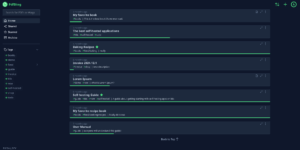In the vast world of Linux, every tool has a special function that makes it stand out from the rest. The stat command is one of those hidden gems, offering a detailed look into the state of our files and file systems. While it may seem like a complex tool at first, in this article, we will unveil its potential in a way that even those less familiar with Linux can understand and take advantage of.
Understanding the Importance of stat
At first glance, many may overlook the stat command. However, its value lies in the details it provides and how it allows us to access crucial information about files and their systems.
Beyond Appearances
Unlike more basic commands like ls, which give a general view of files, stat goes further, showing details such as the inode number, access and modification dates, and much more. These data, while seemingly trivial, are essential for tasks such as troubleshooting or managing files in greater detail.
Linux’s Internal Clock
Every file in Linux has its own “internal clock” that tracks when it was accessed, modified, or changed. stat allows us to read these clocks, which is especially useful for tracking changes or identifying suspicious activity.
Using stat: A Practical Walkthrough
Getting started with stat is simple. Let’s break down how to use it step by step and how to make the most of this tool.
Basic Syntax
The basic use of stat is straightforward. Simply provide the name of the file or directory you want to investigate:
stat filenameThis will output detailed information, such as the file size, access and modification dates, and the inode number.
Common Options in stat
While stat has many options, some of the most commonly used ones are as follows:
-f: Displays information about the file system instead of the file itself. Example:stat -f /homeThis will show details about the file system where the/homedirectory is located, such as the file system type and block size.-c: Allows specifying a custom format for the output, which is useful when you only need specific data. Example:stat -c %s filenameThis command will only show the file size in bytes.
Practical Cases with stat
To truly appreciate the utility of stat, let’s look at a few practical examples.
Tracking Changes
If you suspect that a file has been altered, you can use stat to confirm when it was last modified.
stat file.txtOutput:
File: file.txt
Size: 2048 Blocks: 8 IO Block: 4096 regular file
Device: 803h/2051d Inode: 1234567 Links: 1
Access: 2025-03-30 12:00:00.000000000
Modify: 2025-03-29 15:30:00.000000000
Change: 2025-03-29 15:30:00.000000000
Birth: -In this case, the last modification date is 2025-03-29 15:30:00, showing when the last change occurred.
Managing Disk Space
When managing disk space, stat allows you to see the exact size of files and directories, helping you make informed decisions about what to keep and what to delete. For example, to check the size of a large file:
stat large_file.logOutput:
File: large_file.log
Size: 52428800 Blocks: 10240 IO Block: 4096 regular file
Device: 803h/2051d Inode: 1234578 Links: 1
Access: 2025-03-29 09:00:00.000000000
Modify: 2025-03-28 18:00:00.000000000
Change: 2025-03-28 18:00:00.000000000
Birth: -This file has a size of 52,428,800 bytes (approximately 50 MB), giving you an accurate measure of how much disk space it occupies.
Audits and Security
When conducting an audit or simply wanting to strengthen security, stat allows you to identify access or modification patterns, which can help detect unauthorized or suspicious activities.
For example, if you suspect unauthorized access to a configuration file, you can check its access and modification dates:
stat /etc/secure_configOutput:
File: /etc/secure_config
Size: 4096 Blocks: 8 IO Block: 4096 regular file
Device: 803h/2051d Inode: 6543210 Links: 1
Access: 2025-03-30 10:00:00.000000000
Modify: 2025-03-29 17:00:00.000000000
Change: 2025-03-29 17:00:00.000000000
Birth: -If you see that the access date corresponds to an unusual time or follows a security update, it could be a sign of suspicious activity.
Conclusion
The stat command in Linux is an essential tool for retrieving detailed information about files and file systems. From tracking changes to managing disk space or conducting security audits, stat is an incredibly powerful tool for system administrators and advanced Linux users. By leveraging the various options and functionalities of stat, you can gain much more control over your system, enabling you to make informed decisions and maintain the security and performance of your files and directories.












